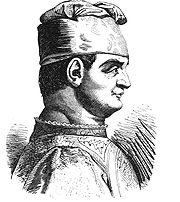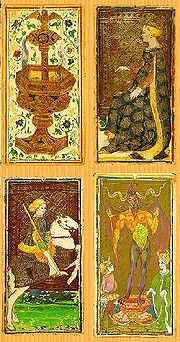
Filippo Maria Visconti
Encyclopedia

Biography
Filippo Maria Visconti, who had become nominal ruler of PaviaPavia
Pavia , the ancient Ticinum, is a town and comune of south-western Lombardy, northern Italy, 35 km south of Milan on the lower Ticino river near its confluence with the Po. It is the capital of the province of Pavia. It has a population of c. 71,000...
in 1402, succeeded his assassinated brother Gian Maria Visconti
Gian Maria Visconti
Gian Maria Visconti was the second Visconti Duke of Milan, the son of Gian Galeazzo Visconti and Caterina Visconti.-Biography:...
as Duke of Milan in 1412. They were the sons of Gian Galeazzo Visconti
Gian Galeazzo Visconti
Gian Galeazzo Visconti , son of Galeazzo II Visconti and Bianca of Savoy, was the first Duke of Milan and ruled the late-medieval city just before the dawn of the Renaissance...
, Gian Maria's predecessor, by his second wife, Caterina Visconti
Caterina Visconti
Caterina Visconti, Duchess of Milan was a member of the Italian noble family Visconti, which ruled Milan from 1277 to 1447. She was the second wife of Gian Galeazzo Visconti, the first Duke of Milan, and was the mother of two succeeding Dukes of Milan, Gian Maria Visconti and Filippo Maria Visconti...
. From Filippo's marriage to Beatrice Lascaris di Tenda
Beatrice Lascaris di Tenda
Beatrice Lascaris di Tenda or Beatrice de Tende or Beatrix , was an Italian noblewoman who was the wife of Facino Cane, Count of Biandrate and a condottiero, and then wife to Filippo Maria Visconti, Duke of Milan, who caused her tragic death.-Family:Beatrice was born in 1370 or 1372 or 1376...
, Countess of Biandrate
Biandrate
Biandrate is a comune in the Province of Novara in the Italian region Piedmont, located about 70 km northeast of Turin and about 12 km west of Novara.-History:...
and the unhappy widow of Facino Cane
Facino Cane
thumb|Facino Cane.Facino Cane da Casale , born Bonifacio Cane, was an Italian condottiero.-Biography:Cane was born in Casale Monferrato to a noble family....
—the condottiere who had fomented strife between the factions of Filippo's elder brother and his mother, Caterina Visconti, the regent—Filippo Maria received a dowry of nearly half a million florins; but when Beatrice took too great an interest in affairs of state, he accused her of adultery and had her beheaded at the castle of Binasco
Binasco
Binasco is a comune in the Province of Milan in the Italian region Lombardy, located about 15 km southwest of Milan. As of 31 December 2004, it had a population of 7,236 and an area of 3.9 km²....
in 1418.
Cruel, paranoid and extremely sensitive about his personal ugliness, he was nevertheless a great politician
Politician
A politician, political leader, or political figure is an individual who is involved in influencing public policy and decision making...
, and by employing such powerful condottieri
Condottieri
thumb|Depiction of [[Farinata degli Uberti]] by [[Andrea del Castagno]], showing a 15th century condottiero's typical attire.Condottieri were the mercenary soldier leaders of the professional, military free companies contracted by the Italian city-states and the Papacy, from the late Middle Ages...
as Carmagnola
Francesco Bussone da Carmagnola
Francesco Bussone, often called Count of Carmagnola , was an Italian condottiero.- Biography :Francesco Bussone was born at Carmagnola, near Turin, in a humble peasant family....
, Piccinino
Niccolò Piccinino
Niccolò Piccinino was an Italian condottiero.-Biography:He was born at Perugia, was the son of a butcher.He began his military career in the service of Braccio da Montone, who at that time was waging war against Perugia on his own account, and at the death of his chief, shortly followed by that of...
—who unsuccessfully led his troops at the Battle of Anghiari
Battle of Anghiari (1440)
The Battle of Anghiari was fought on June 29, 1440, between Milan and the Italian League led by Republic of Florence in the course of the Wars in Lombardy....
, 1440— and Francesco Sforza, he managed to recover the Lombard portion of his father's duchy.

Giorgio Ordelaffi
Giorgio Ordelaffi was lord of Forlì and Papal vicar in Romagna . He was a member of the Ordelaffi family.The son of Teobaldo Ordelaffi, he married Lucrezia Alidosi...
, lord of Forlì
Forlì
Forlì is a comune and city in Emilia-Romagna, Italy, and is the capital of the province of Forlì-Cesena. The city is situated along the Via Emilia, to the right of the Montone river, and is an important agricultural centre...
, he took advantage of his guardianship of the boy heir, Tebaldo Ordelaffi, to attempt conquests in Romagna
Romagna
Romagna is an Italian historical region that approximately corresponds to the south-eastern portion of present-day Emilia-Romagna. Traditionally, it is limited by the Apennines to the south-west, the Adriatic to the east, and the rivers Reno and Sillaro to the north and west...
(1423), provoking war with Florence
Florence
Florence is the capital city of the Italian region of Tuscany and of the province of Florence. It is the most populous city in Tuscany, with approximately 370,000 inhabitants, expanding to over 1.5 million in the metropolitan area....
, which could not permit his ambitions to go uncontested. Venice
Venice
Venice is a city in northern Italy which is renowned for the beauty of its setting, its architecture and its artworks. It is the capital of the Veneto region...
, urged on by Francesco Bussone da Carmagnola
Francesco Bussone da Carmagnola
Francesco Bussone, often called Count of Carmagnola , was an Italian condottiero.- Biography :Francesco Bussone was born at Carmagnola, near Turin, in a humble peasant family....
, decided to intervene on the side of Florence (1425) and the war spread to Lombardy. In March 1426 Carmagnola fomented riots in Brescia
Brescia
Brescia is a city and comune in the region of Lombardy in northern Italy. It is situated at the foot of the Alps, between the Mella and the Naviglio, with a population of around 197,000. It is the second largest city in Lombardy, after the capital, Milan...
, which he had conquered for Visconti just five years previously. After a long campaign, Venice conquered Brescia, extending its mainland possessions to the eastern shores of Lake Garda
Lake Garda
Lake Garda is the largest lake in Italy. It is located in Northern Italy, about half-way between Brescia and Verona, and between Venice and Milan. Glaciers formed this alpine region at the end of the last ice age...
. Filippo Maria unsuccessfully sought imperial aid but was constrained to accept the peace proposed by Pope Martin V
Pope Martin V
Pope Martin V , born Odo Colonna, was Pope from 1417 to 1431. His election effectively ended the Western Schism .-Biography:...
, favoring Venice and Carmagnola. The terms were grudgingly accepted in Milan and by the emperor; but hostilities were resumed at the first pretext by Filippo Maria, leading to the defeat of Maclodio (12 October 1427), followed by a more lasting peace signed at Ferrara
Ferrara
Ferrara is a city and comune in Emilia-Romagna, northern Italy, capital city of the Province of Ferrara. It is situated 50 km north-northeast of Bologna, on the Po di Volano, a branch channel of the main stream of the Po River, located 5 km north...
with the mediation of Niccolò III d'Este
Niccolò III d'Este
Niccolò III d'Este was Marquess of Ferrara from 1393 until his death. He was also a condottiero.-Biography:...
.
The following year the duke married his second wife Maria di Savoia (1411–1469), daughter of Duke Amadeus VIII of Savoy, a potent ally. With Visconti's support, Amadeus reigned briefly as antipope Felix V from November 1439 to April 1449.
He invited the famous scholar Gasparino Barzizza to establish a school at Milan. Barzizza also served as his court orator.
He died in 1447, the last of the Visconti
House of Visconti
Visconti is the family name of two important Italian noble dynasties of the Middle Ages. There are two distinct Visconti families: The first one in the Republic of Pisa in the mid twelfth century who achieved prominence first in Pisa, then in Sardinia where they became rulers of Gallura...
in direct male line, and he was succeeded in the duchy, after the short-lived Ambrosian republic
Ambrosian Republic
The Golden Ambrosian Republic was a short-lived government founded in Milan by members of the University of Pavia with popular support...
, by Francesco Sforza (1401-1466), who had married in 1441 Filippo Maria's only heir, his natural daughter Bianca Maria
Bianca Maria Visconti
Bianca Maria Visconti was Duchess of Milan from 1450 to 1468.-Early years:Born near Settimo Pavese, Bianca Maria was the illegitimate daughter of Filippo Maria Visconti, Duke of Milan and last of the Visconti rulers, and Agnese del Maino, the only person the shy, secluded Filippo ever loved...
(1425-1468) by his mistress Agnese del Maino
Agnese del Maino
Agnese del Maino was a Milanese noblewoman and the mistress of Filippo Maria Visconti, the last legitimate Duke of Milan of the Visconti dynasty. Agnese was the mother of Bianca Maria Visconti, who succeeded to the title of Duchess of Milan in 1450, despite her illegitimacy.- Family :Agnese was...
(1401-1465).
Art
The oldest extant Tarot decksTarot
The tarot |trionfi]] and later as tarocchi, tarock, and others) is a pack of cards , used from the mid-15th century in various parts of Europe to play a group of card games such as Italian tarocchini and French tarot...
, then called carte da trionfi, were probably commissioned by Filippo Maria Visconti http://trionfi.com/0/b.

